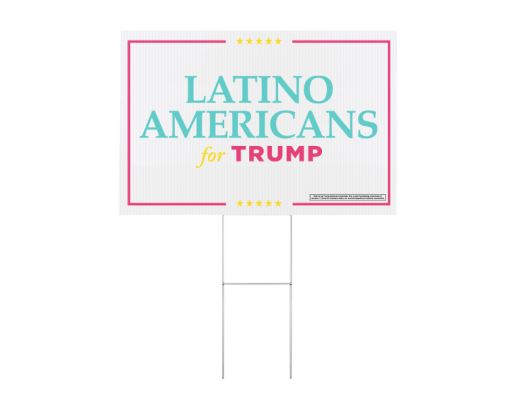
Supporters of former President Donald Trump watch as he holds a rally in the historical Democratic district of the South Bronx on May 23, 2024 in New York City. The Bronx, home to a large Latino community, has been a Democratic base for generations of voters and the rally occurred as Trump looks to attract more non-white voters. (Photo by Spencer Platt/Getty Images)
Donald Trump made significant inroads among several traditional Democratic Party constituencies, cutting into Democratic margins among Black and Hispanic voters. A new paper looking at his gains among Hispanic voters puts forward a provocative argument to explain some of that movement.
It contends that Hispanic voters who hold socially conservative, anti-LGBTQ views but might otherwise have voted Democratic have become turned off by Democratic politicians’ use of the gender-neutral term “Latinx,” which is being used “to explicitly include gender minorities and broader LGBTQ+ community segments.”
Based on their analysis of a set of population surveys conducted in recent years, Marcel Roman, an assistant professor of government at Harvard, and Amanda Sahar d’Urso, an assistant professor of government at Georgetown University, say Latinos are less likely to support a politician who uses the term “Latinx” in their appeal to voters.
They say the move away from Democratic candidates using the term appears to be driven by the subset of Latino voters who hold negative attitudes toward the LGBTQ community and is not based on a broader reaction against the new term, which first began to appear about 20 years ago.
“We find that backlash is not driven by concerns related to respect for the Spanish language or anti-intellectual beliefs – that Latinx is a bourgeois, coastal, white imposition on working-class Latinos,” Roman said in an interview. “The reason why it generates backlash against some aspects of the Democratic Party is it’s a signal of inclusivity toward LBGTQ+ and gender non-conforming” members of the Latino community.
Their paper also digs into Hispanic voter patterns in areas where they say the use of Latinx has had particularly high “salience,” measured by the level of internet search activity, which Roman and d’Urso say serves as a reasonable proxy for its presence in the political discourse of local candidates. Among Hispanic voters with negative views toward LGBTQ people, they found that there was greater movement toward Trump from the 2016 election to the 2020 election if they lived in areas with higher Latinx “salience.”
Nationally, there was about an 8 percentage point swing toward Trump among Hispanic voters from 2016 to 2020. Biden still captured a majority of Hispanic votes four years ago – 61%, according to one estimate – but if the movement by Hispanic voters toward Trump continues in the current election, it could be ominous for Democratic chances.
The paper says use of the term among Democratic politicians surged in recent years. Kamala Harris and Elizabeth Warren both used it in the 2020 presidential campaign, and Joe Biden used it in a 2021 speech on Covid vaccine compliance. Among Democratic members of Congress, the study says, just 10% used Latinx in social media posts during the 2015-2016 session, but by the 2019-2020 session fully half had done so. By contrast, they say, not a single Republican member of Congress has invoked the term on social media.
Amid his harsh rhetoric toward immigrants, Trump has nonetheless won support among Hispanic voters who don’t see themselves in those attacks.
“The us-versus-them framing has long characterized political alliances, across the ideological spectrum,” the New York Times said in a story Tuesday on Trump’s appeals to Black and Latino voters. “But Mr. Trump has been far more direct than any recent presidential candidate in inviting Black and Latino voters to be part of the ‘us,’ so long as they acknowledge that there is a ‘them.”
Underscoring the findings by Roman and d’Urso on the power of anti-LGBT views among a swath of Hispanic voters is Trump’s explicit attempt to win support on the issue.
“In one of the Trump campaign’s most widely broadcast Spanish-language television ads, attacking Ms. Harris for her support of transgender medical care for immigrants, it closes with ‘Kamala Harris is with them. President Trump is with us.’”
Roman said Democrats appear to have recognized the electoral costs that may come with use of the term Latinx. “The Democratic Party has kind of course corrected,” he said, with Harris and Biden not using the term since early 2021. “The Democratic Party at the national level recognized it may do more harm than good,” he said. But Roman said some “damage may be done” already in terms of the association of the term with Democrats.
Based on his findings, Roman said abandoning the term Latinx is a strategically smart move by Democrats. For his part, however, Roman sees the term as a welcome evolution in language precisely because of what it signals. “I think, in general, inclusive language is good,” he said. “It’s not the phrase that’s the problem. It’s that people hold queer-phobic attitudes – that’s the problem.” Shifting that reality, he said, is “a much larger undertaking.”
This article first appeared on CommonWealth Beacon and is republished here under a Creative Commons license.
GET THE MORNING HEADLINES.

